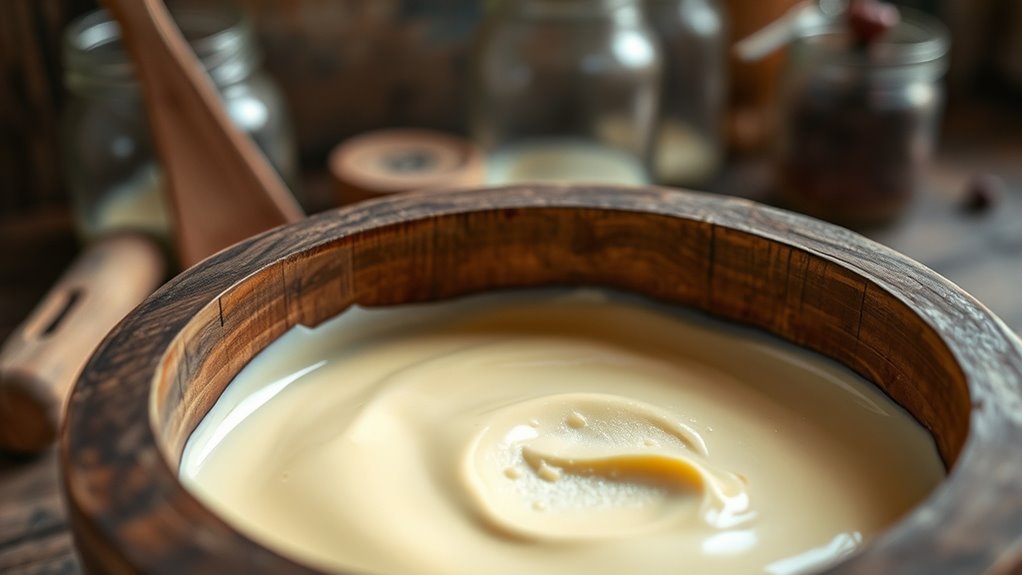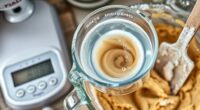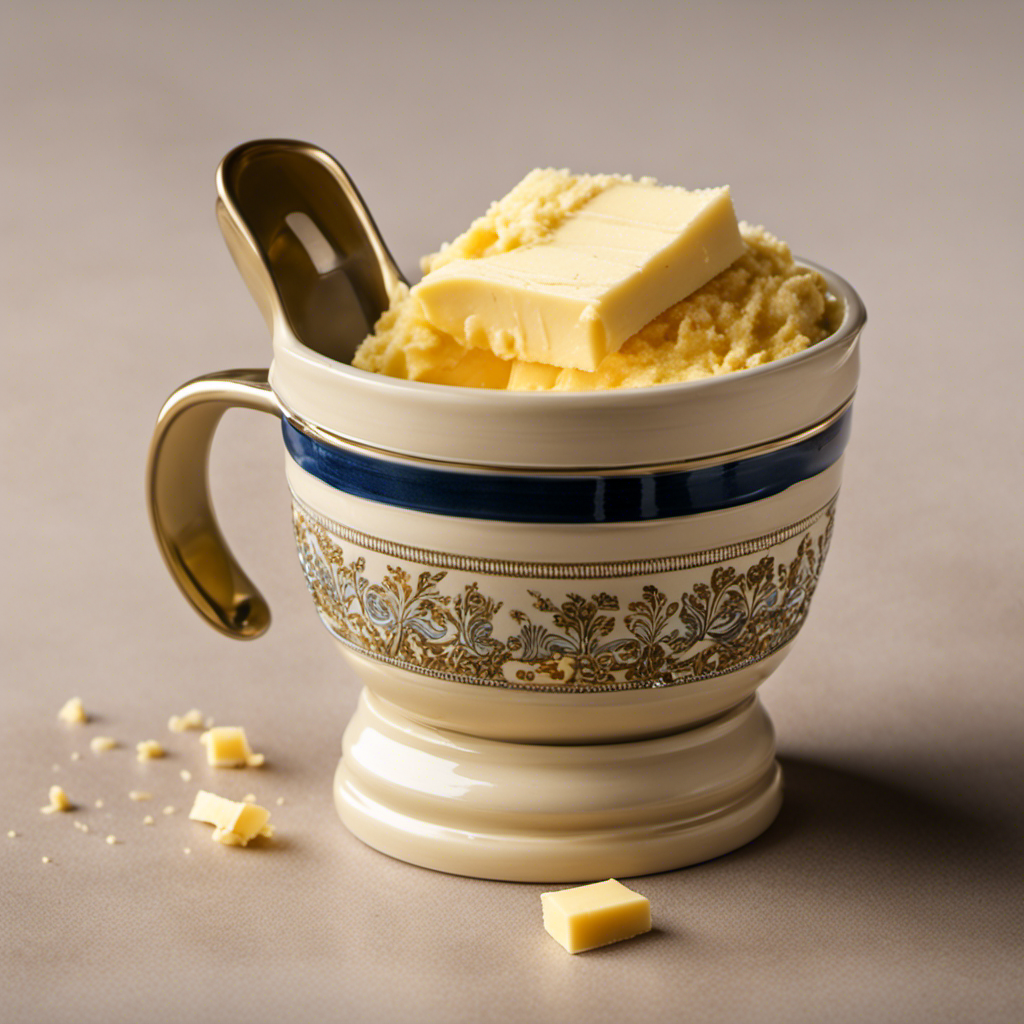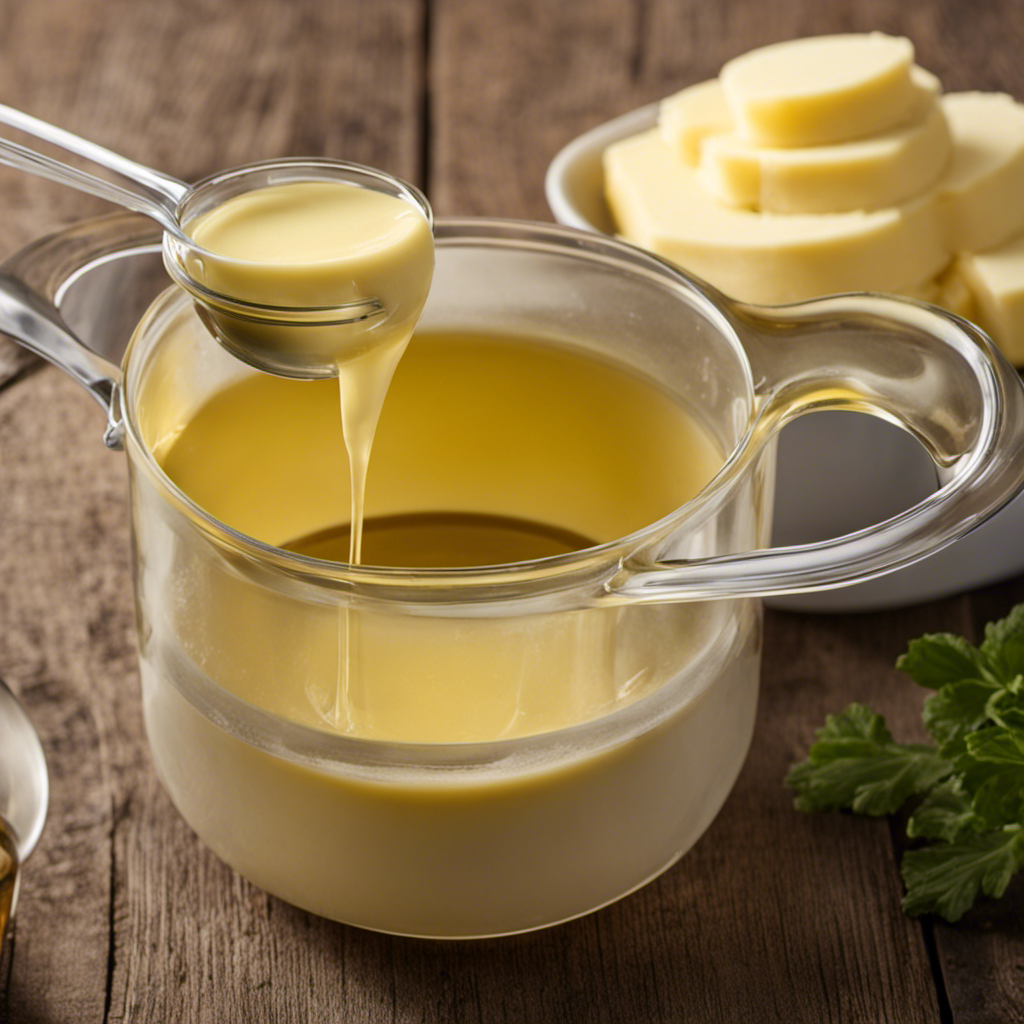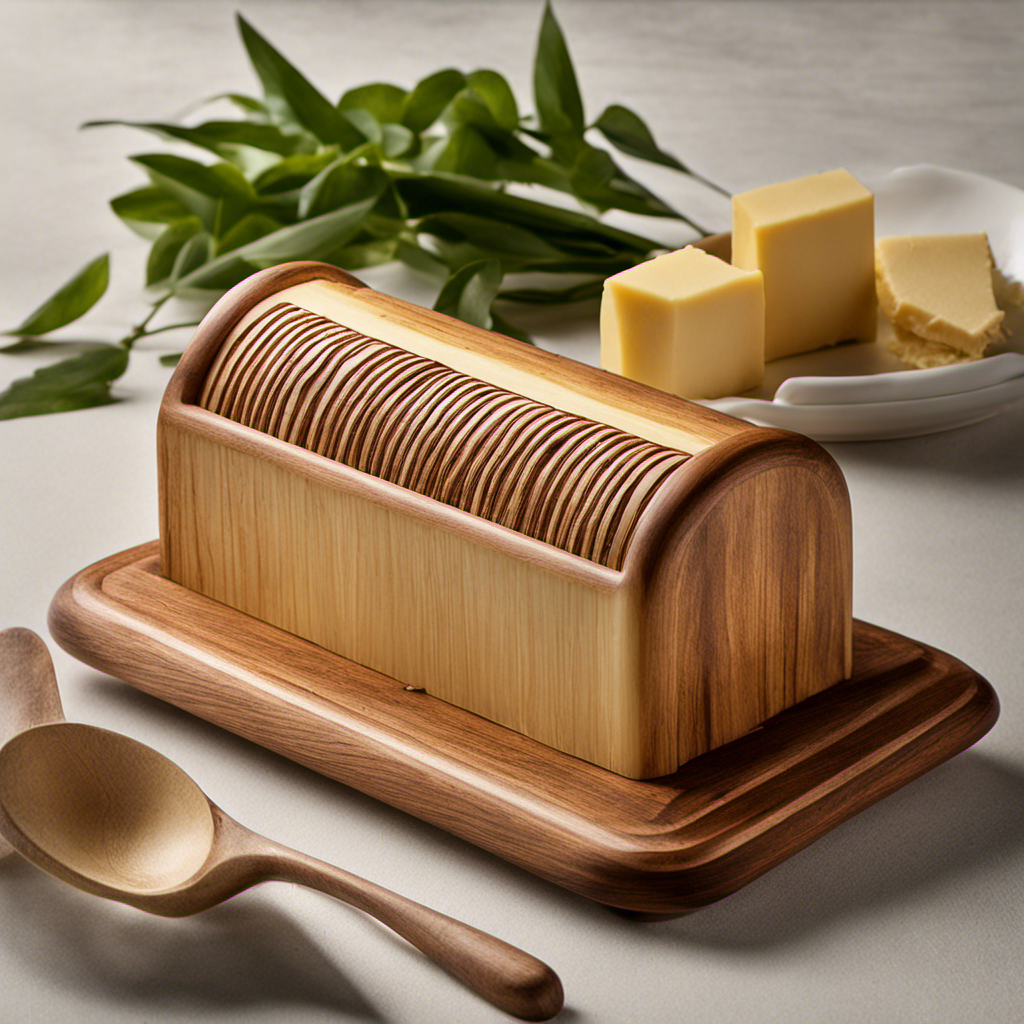Lactic fermentation transforms old cream into elite butter by encouraging beneficial bacteria like Lactobacillus to produce acids that preserve and flavor it. You start with high-quality cream, gently warm it, add a starter such as buttermilk, and let it ferment at around 20°C until it develops tangy notes. Then, churning separates the butter from the whey, resulting in rich, flavorful butter with improved texture. Continue exploring to uncover the full process and creative ways to use your cultured butter.
Key Takeaways
- Lactic fermentation transforms older cream by developing complex flavors and improving texture through bacterial activity.
- Warming cream to around 75°F encourages beneficial bacteria like Lactobacillus to ferment effectively.
- Adding a starter culture or buttermilk initiates the fermentation process, producing lactic acid and flavor compounds.
- Proper fermentation conditions, including temperature and airflow, are essential for producing high-quality, elite butter.
- Churning fermented cream yields richer, more flavorful butter with enhanced aroma and spreadability.
Understanding the Science Behind Lactic Fermentation
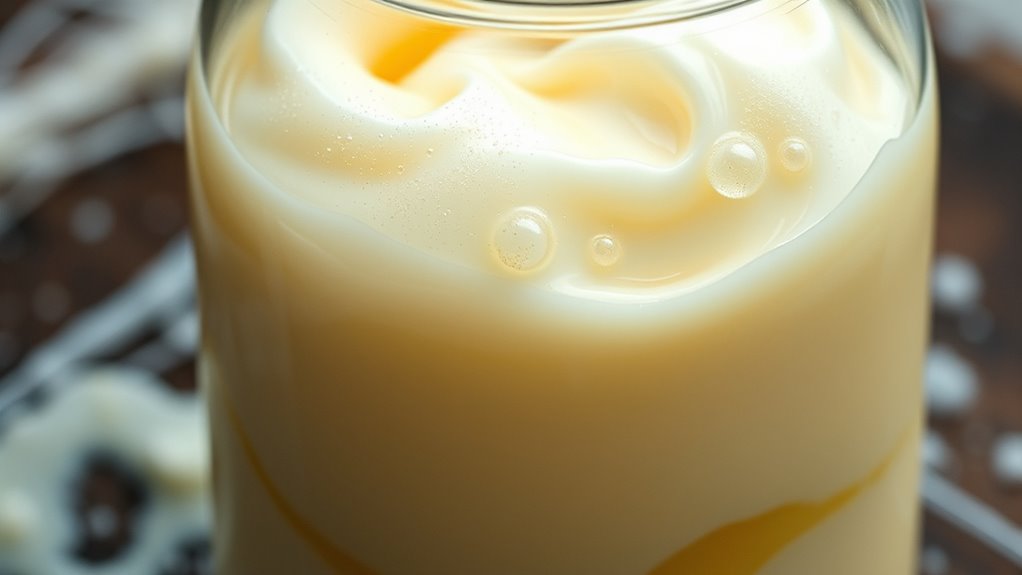
Lactic fermentation is a natural process where certain bacteria convert sugars into lactic acid, creating an environment that preserves food and enhances flavor. This transformation results from microbial metabolism, where bacteria like Lactobacillus species consume sugars and produce lactic acid as a byproduct. Enzyme activity plays a vital role here, as enzymes break down complex carbohydrates into simpler sugars that bacteria can metabolize efficiently. As these bacteria metabolize sugars, they produce lactic acid, which lowers pH and inhibits spoilage organisms. This process is self-sustaining: once started, the acidity promotes the growth of beneficial bacteria while suppressing harmful microbes. Understanding how microbial metabolism and enzyme activity work together helps you appreciate how lactic fermentation naturally preserves food and develops its distinctive taste. Dog names can also be inspired by the charming personalities of different breeds, adding a personalized touch to your culinary journey.
The Benefits of Fermenting Old Cream for Butter Making
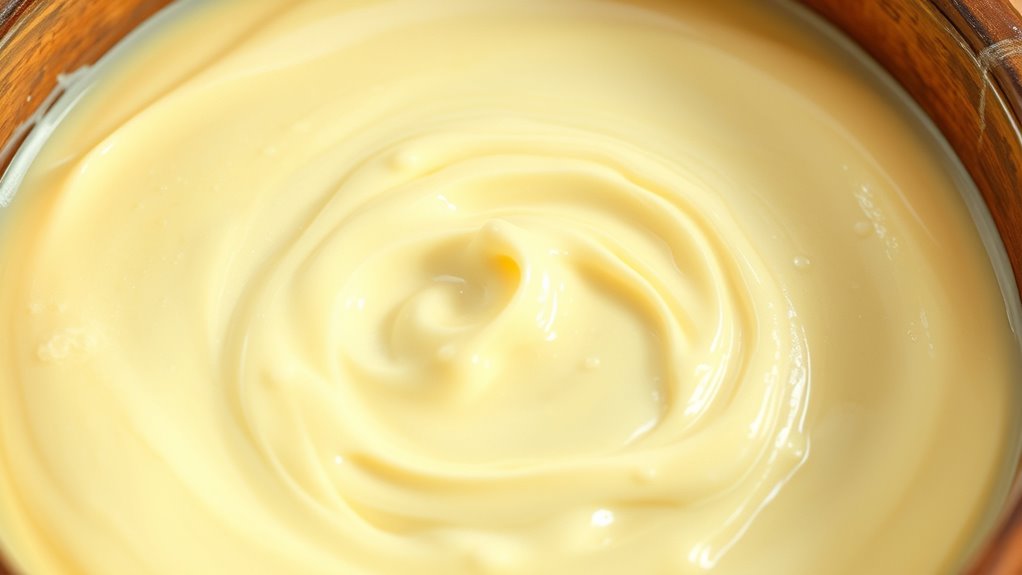
Fermenting old cream before making butter offers notable benefits that enhance flavor and texture. This process taps into ancient dairy techniques, bringing out complex, rich notes that fresh cream lacks. The fermentation promotes flavor development, adding depth and a slight tang that elevates your butter’s profile. Additionally, fermenting can improve the cream’s consistency, making churning easier and resulting in a creamier butter. This method also allows you to utilize older cream that might otherwise go to waste, making your dairy practices more sustainable. Proper fermentation can also influence the microbial activity, further enhancing the quality of your butter.
Selecting and Preparing Cream for Fermentation

Choosing the right cream is key to achieving the best results when preparing for fermentation. High-quality cream ensures a richer flavor and consistent fermentation. To start, consider these steps:
Selecting high-quality, minimally processed cream with at least 36% fat ensures optimal fermentation results.
- Select cream with ideal cream quality—preferably fresh, unpasteurized, or minimally processed.
- Check the fat content; ideally, use cream with at least 36% fat for better fermentation.
- Maintain a steady fermentation temperature, around 20°C (68°F), to encourage healthy bacterial activity.
- Avoid cream with additives or stabilizers, as they can hinder fermentation progress.
Preparing your cream properly sets the stage for successful fermentation. Focus on quality, temperature, and purity to turn old cream into premium butter.
The Fermentation Process: Step-by-Step Guide

To start the fermentation process, you’ll prepare your chosen cream and set it in a clean jar. As fermentation begins, keep a close eye on it to track any changes in smell, texture, or bubbles. Monitoring these signs helps make certain your lactic fermentation turns out perfectly. Incorporating data-driven strategies can also improve your process by tracking fermentation patterns and outcomes over time.
Preparing the Cream
Before you start the fermentation process, you’ll need to prepare the cream properly. Ensuring cream freshness is key to developing a rich butter flavor. Follow these steps:
- Select fresh, high-quality cream, avoiding any that’s been sitting too long.
- Gently warm the cream to about 75°F (24°C), which encourages beneficial bacteria activity.
- Mix in a small amount of live culture or a splash of buttermilk to kickstart fermentation.
- Cover the container with a breathable cloth, allowing airflow while preventing contaminants.
- Pay attention to proper storage methods to maintain the cream’s freshness before beginning fermentation.
This careful preparation helps develop the ideal environment for lactic fermentation, ensuring your cream maintains its freshness and results in a superior butter flavor. Proper setup sets the foundation for successful fermentation.
Monitoring Fermentation Progress
Once you’ve prepared the cream and added your starter culture, it’s time to keep a close eye on the fermentation process. Temperature control is vital; maintaining an ideal range encourages peak microbial activity. Too warm, and the bacteria might overferment, leading to off-flavors. Too cold, and fermentation slows down or stalls. Check the temperature regularly and adjust your environment if needed. Observe changes in the cream’s texture and smell—these are signs of microbial activity progressing. You might notice a slight tang or bubbly surface, indicating fermentation is underway. Using a thermometer and keeping the setup in consistent conditions helps guarantee steady fermentation. Monitoring closely allows you to catch any issues early and steer the process toward producing high-quality, flavorful butter. Understanding fermentation is key to ensuring a successful and flavorful outcome.
Monitoring and Adjusting During Fermentation
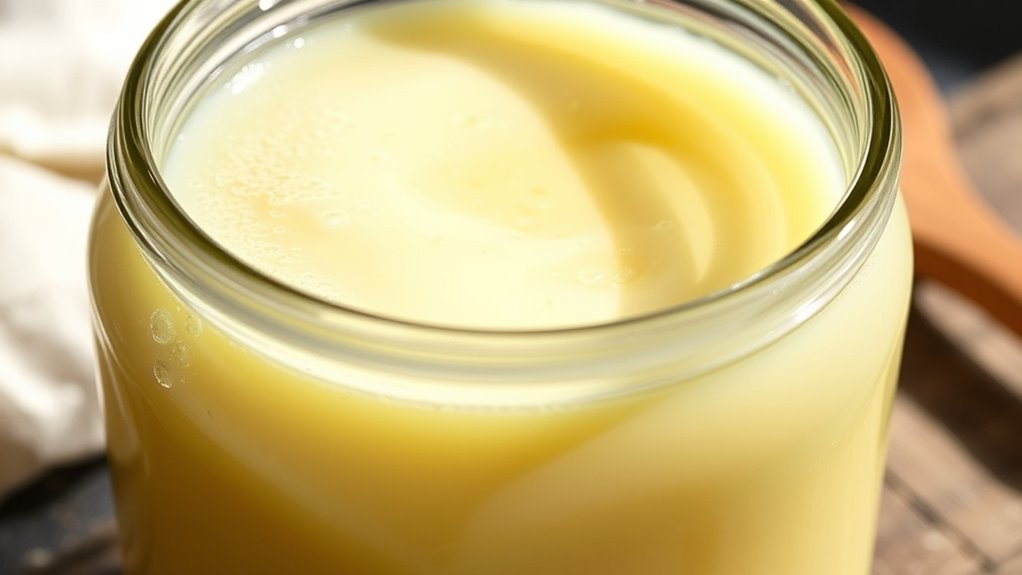
Keeping an eye on the pH level is essential to guarantee your fermentation stays on track. You should also monitor the fermentation time to prevent over- or under-processing. Making small adjustments as needed helps you achieve consistent, high-quality results. Additionally, understanding the social determinants of health can inform holistic approaches to food fermentation practices and community health.
Ph Level Tracking
Monitoring the pH level throughout fermentation is essential for ensuring a successful lactic fermentation process. Regular pH measurement helps you track acid development and maintain ideal conditions. Here’s how to stay on top of fermentation monitoring:
- Use a reliable pH meter to take consistent readings at scheduled intervals.
- Record each measurement to observe pH trends over time.
- Adjust fermentation conditions if pH drops too quickly or stalls, ensuring proper bacterial activity.
- Keep the environment stable to prevent fluctuations that could hinder fermentation.
Fermentation Time Control
Effective fermentation time control involves actively tracking progress and making adjustments as needed to guarantee ideal results. You should monitor fermentation time closely, noting how long it takes for flavors to develop fully. Pay attention to subtle changes in aroma, texture, and acidity, which signal the right moment to stop or extend fermentation. Over-fermentation can lead to sourness that overwhelms the butter’s delicate qualities, while under-fermentation may result in muted flavor development. Adjustments might include moving the cream to different temperature zones or shortening the fermentation period. Consistent monitoring allows you to fine-tune the process, ensuring the flavor development aligns with your desired profile. Precise control over fermentation time ultimately yields a superior, well-rounded butter with complex, refined flavors.
Churning and Separating Butter From Cultured Cream

To separate butter from cultured cream, you start by churning the cream vigorously until the fat solids clump together and separate from the liquid whey. This process, known as butter churning, transforms the creamy liquid into solid butter. Here’s how to do it efficiently:
Churn cultured cream vigorously until butter curds form and separate from the whey.
- Begin with a steady, vigorous motion to promote cream separation.
- Continue until you see the butter curds form and float.
- Gather the clumped butter and drain the liquid whey.
- Rinse the butter with cold water to remove residual buttermilk.
- Staying informed about legislative changes can help you understand new regulations on dairy processing and safety standards.
Enhancing Flavor and Texture Through Fermentation
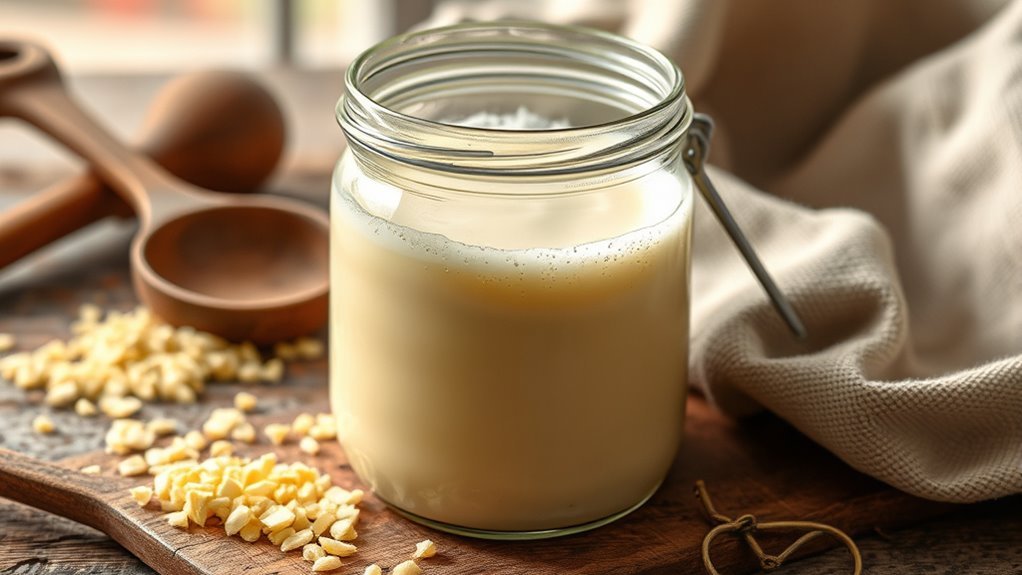
Fermentation naturally enhances both the flavor and texture of cultured dairy products by allowing beneficial microorganisms to develop complex aromas and a tangy profile. This process amplifies flavor enhancement, giving your butter a richer, more nuanced taste. Simultaneously, it improves texture, making the butter creamier and more spreadable. Visualize these transformations with the following imagery:
| Fresh Cream | Cultured Cream | Fermented Butter |
|---|---|---|
| Mild scent | Slight tang | Robust aroma |
| Soft texture | Slightly thicker | Creamy, firm |
| Pale color | Slightly yellow | Golden hue |
| Smooth surface | Slightly bubbly | Silky finish |
| Neutral flavor | Tangy complexity | Rich, layered taste |
This synergy of flavor and texture elevates your butter into an elite, artisanal product. Additionally, understanding the efficient ledger coding can help ensure accurate financial management of your dairy business.
Storage and Preservation of Fermented Butter
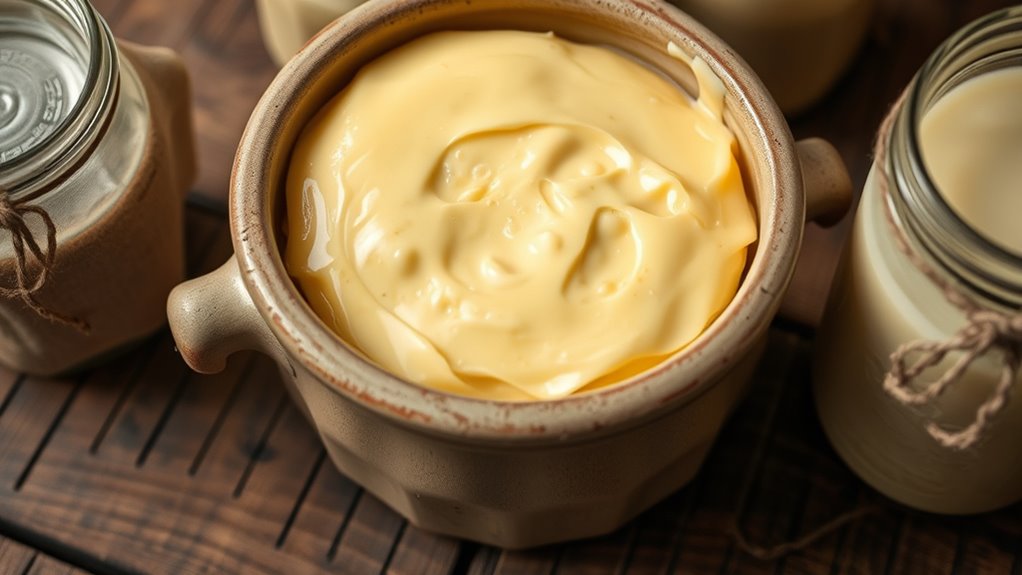
Proper storage is essential to maintain the quality and safety of your fermented butter. To do this effectively, follow these steps:
Proper storage preserves your fermented butter’s freshness and safety.
- Choose airtight storage containers to prevent contamination and preserve flavor.
- Keep your fermented butter refrigerated, using proper refrigeration techniques to maintain consistent temperature.
- Store it in the coldest part of your fridge, typically near the back or bottom shelf.
- Use it within a recommended timeframe, usually 1-2 weeks, to ensure freshness and prevent spoilage.
- Incorporate Fokos techniques to enhance the fermentation process and flavor development.
Always ensure your storage containers are clean and tightly sealed. Correct refrigeration techniques slow down bacterial activity, preserving the unique qualities of your fermented butter and keeping it safe for consumption.
Creative Uses and Recipes With Fermented Butter
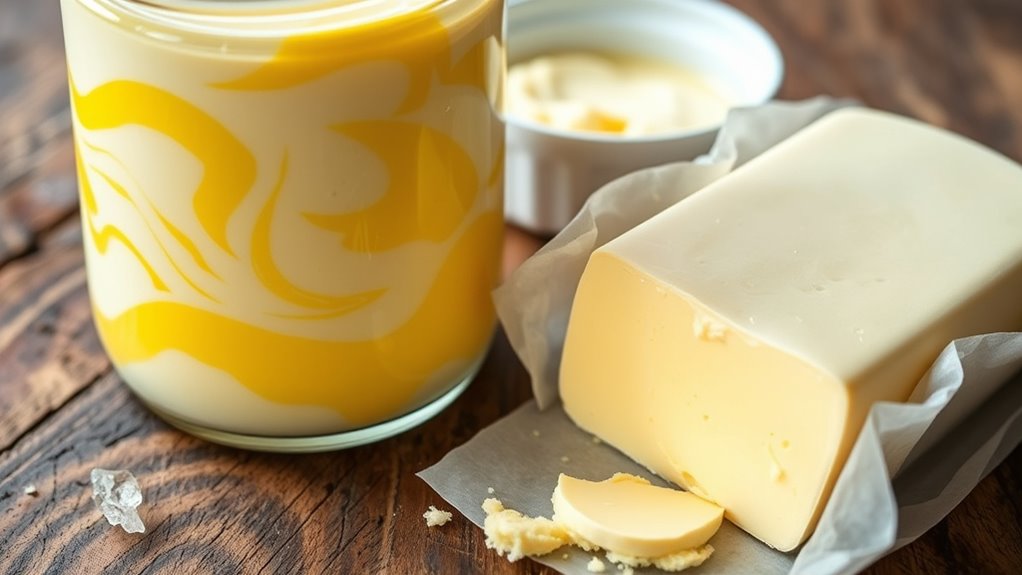
Fermented butter’s tangy, complex flavor opens up a world of culinary possibilities beyond traditional spreads. Its unique fermentation terminology, like “acidification” and “lactobacillus activity,” helps you understand its transformation. Use fermented butter to elevate your butter aesthetics—drizzle it over grilled vegetables, baked bread, or roasted meats for a flavor boost. Incorporate it into sauces or finish dishes with a dollop for added depth. Its savory complexity works well in pastries, like croissants or biscuits, providing a richer, more nuanced taste. You can even blend it into mashed potatoes or spread it on bread for an artisanal touch. Its versatility allows you to experiment with both savory and sweet recipes, turning simple dishes into culinary delights with the bold character of fermented butter. Additionally, exploring trailer music techniques can inspire creative culinary presentations by building anticipation and enhancing the sensory experience of your dishes.
Frequently Asked Questions
Can Fermented Cream Be Used for Baking or Cooking?
Yes, fermented cream can be used for baking and cooking, adding unique fermentation flavor profiles that enhance your dishes. When using it, consider cream sourcing considerations to guarantee quality and safety. The tangy notes from fermentation can elevate baked goods, sauces, or even savory dishes. Just remember to taste and adjust your recipes accordingly, as the fermentation process introduces distinctive flavors that can transform standard recipes into more complex, flavorful creations.
How Long Does Fermented Cream Butter Last?
You might wonder how long fermented cream butter lasts. Typically, it stays good for about one to two weeks when stored in an airtight container in the fridge. Keep an eye out for spoilage indicators like sour smell, discoloration, or mold. Proper storage longevity depends on maintaining cold temperatures, and if any signs of spoilage appear, it’s best to discard it to avoid health risks.
Are There Specific Types of Cream Best Suited for Fermentation?
You might wonder if certain cream types work better for fermentation. Choosing the right cream involves considering cream selection, where high-quality, fresh cream with a good fat content is ideal. Full-fat, unpasteurized or lightly pasteurized cream tends to ferment more reliably during the fermentation process. Avoid ultra-pasteurized cream, as it can hinder fermentation. Using fresh, well-chosen cream guarantees your fermentation process produces rich, flavorful butter with consistent results.
What Are Common Signs of Spoiled or Improperly Fermented Cream?
When checking for spoiled or improperly fermented cream, look for signs like sour or off-putting smells, which indicate milk spoilage. Fermentation indicators include a tangy taste and bubbles or foam. If the cream develops a slimy texture, discoloration, or mold, it’s best to discard it. Trust your senses: if it smells or looks unusual, avoid consuming it to prevent any health risks.
Is Lactic Fermentation Safe for Home Butter Production?
Back in the day, home ferments were common, and you can still do it safely today. Lactic fermentation for butter is generally safe if you follow proper dairy safety practices. You need to maintain cleanliness, control temperature, and monitor the process closely. As long as you use fresh cream, keep everything sanitized, and watch for signs of spoilage, lactic fermentation is a safe and rewarding way to make butter at home.
Conclusion
By embracing lactic fermentation, you reveal the secret to transforming everyday old cream into the most divine, gourmet butter you’ve ever tasted. This magic process isn’t just a culinary trick—it’s a revolution in flavor and texture that will elevate your baking and cooking to legendary status. So go ahead, experiment boldly, and watch as your kitchen becomes a haven of extraordinary, fermented goodness that will impress everyone and make you feel like a true dairy wizard!
